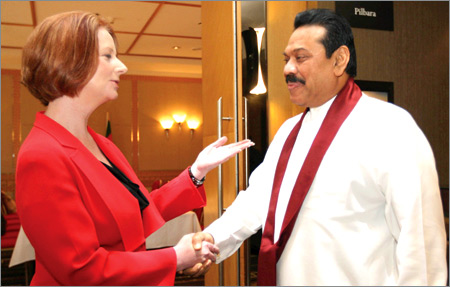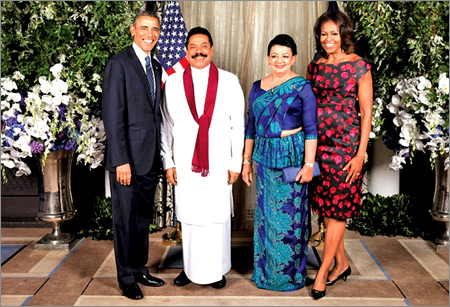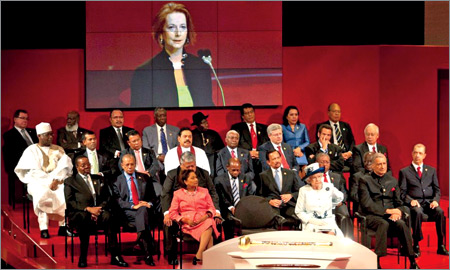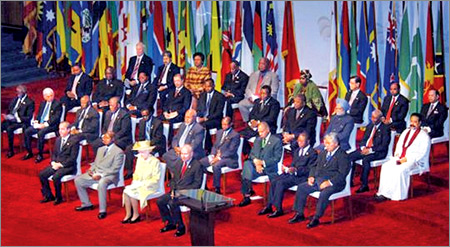International relations at its peak
 |
|
President Mahinda
Rajapaksa greets former Australian Prime Minister Julia
Gillard in Perth in 2011 |
November 18, 2005 was a red letter day in the annals of history for
all Sri Lankans not merely because of the election of Sri Lanka's fifth
Executive President but more so because it opened a new chapter which
changed the destiny of a nation, plagued by terrorism and an economy on
the brink of collapse.
When President Mahinda Rajapaksa took office as the First Citizen,
the country was grappling with all odds to maintain its sovereignty and
territorial integrity since LTTE terrorism was at its peak.
 |
|
President Mahinda
Rajapaksa and First Lady Shiranthi Rajapaksa with US
President
Barack Obama and US First Lady Michelle Obama |
Moreover, the country's economy was in a near state of collapse due
to three decades of terrorism and the country's future was bleak.
Nobody in their wildest dreams ever thought Sri Lanka would bounce
back from the ashes of terrorism to achieve the current impressive
economic growth it maintains as an emerging nation. Nevertheless,
President Rajapaksa had implicit faith in himself and the support of the
nation to beat all overwhelming odds.
 |
|
President Mahinda
Rajapaksa at the CHOGM summit in Perth, Australia in 2011 |
It is indisputable that due to his illustrious political leadership
Sri Lanka vanquished the most ruthless terrorist outfit in the world to
enter the superhighway of development and set a goal to become the
Wonder of Asia.
 |
|
President Mahinda
Rajapaksa takes part in a CHOGM summit |
Hence, November 18, 2005 went down in history as the date which
changed the destiny of a nation and the beginning of a new era under the
Lion flag to build a unified nation. With President Rajapaksa completing
eight years in office as the Executive President, the country has not
only won its battle against terror but has also been put on the right
track to win the economic war as well.
When President Rajapaksa was first elected to high office in 2005,
LTTE terrorism was tearing the country apart, following the
controversial Ceasefire Agreement (CFA) entered into by the then UNP
Government of Ranil Wickremesinghe.
It was the intrepid and far-sighted political sagacity of President
Rajapaksa that inspired the Security Forces to end LTTE terror and
liberate the country from the scourge of terrorism. Had it not been for
the right political backing and guidance, the Security Forces would not
have rewritten Sri Lanka's military history.
Thanks to the indefatigable efforts of President Rajapaksa and
Defence Secretary Gotabaya Rajapaksa, the Security Forces liberated the
entire country from the clutches of terrorism on May 18, 2009. Only a
handful of people were confident that Sri Lanka could achieve this
gigantic task. However, the President directed the valiant Security
Forces on the right track, supported them wholeheartedly and was indeed
a tower of strength to them at all times.
Eradicating terrorism had been a pipe-dream for decades and it was
President Rajapaksa who proved in no uncertain terms that Sri Lanka's
Security Forces could perform that Herculean task.
Having paved the way for a peaceful Sri Lanka for all communities to
live in harmony, the President embarked on another ambitious program to
take Sri Lanka towards economic prosperity.
The fruits of the economic drive have already become significant with
the development Sri Lanka has achieved with the right economic policies
implemented by the Government under the Mahinda Chinthana.
Although the Government had to embark on a massive humanitarian
operation against the world's most barbaric terrorist outfit, the
President went ahead with the country's development. Despite a colossal
sum of money being allocated for national security, an equal amount of
funds were allocated for development. The Government achieved military
success hand in hand with the development projects launched.
What is all the more significant is that none of the subsidies was
curtailed although the Government spent staggering amounts of money on
defence and development. The Government had granted a massive 96 percent
fertiliser subsidy to help farmers and, moreover, increased the
budgetary allocations on health and education.
Having accomplished the biggest human rescue operation in world
history to liberate over half a million people held by the LTTE as a
human shield, President Rajapaksa also ensured that the future of those
who were rescued from the jaws of LTTE terror was secure. Hence, the
Government expended billions of rupees to develop the Northern and
Eastern Provinces. The mega development projects implemented in the two
provinces helped achieve a record 25 percent growth rate, compared to
the country's overall performance of over seven percent.
The outstanding manner in which the Government took care of displaced
persons and resettled them in double quick time was indeed a record
which no other country has achieved after a conflict situation.
Even terrorists who had been engaged in an armed struggle against a
democratically elected political leadership have been rehabilitated and
provided life skills development and the wherewithal to begin a new life
as loyal citizens of Mother Lanka. People in the North and the East have
now become the major stakeholders of the country's economic boom.
The Government has taken several far-reaching decisions to boost the
rural economy and increase local production.
To achieve these goals, many tangible steps have been taken under the
Api Wawamu, Rata Nagamu program. Rural agro and dairy products have
fetched a better price, enhancing the villagers' purchasing power, a
unique achievement which has encouraged more people in the provinces to
take to cultivation which in turn would strengthen Sri Lanka's economy.
The Government has spared no pains to implement the Mahinda Chinthana
policy which aims at socio-economic development of this thrice-blessed
land. Sri Lanka has maintained a clear-cut foreign policy whilst
protecting its rights as a sovereign nation. The country's sovereignty
and territorial integrity have been the Government's top priority at all
times.
Simultaneously, Sri Lanka has strengthened its international
relations and many friendly countries have firmly backed Sri Lanka in
its battle against terrorism. Though certain international organisations
with vested interests attempted to retard military operations, Sri
Lanka's friendly countries remained a source of inspiration.
This is largely due to the strong ties the President has maintained
with the leaders of those countries. All peace-loving and patriotic
citizens amply demonstrated their gratitude to the leader who saved the
nation from disaster in no uncertain terms by electing him for a second
term in office with a landslide victory at the 2010 Presidential
election.
No other leader worth his salt in Sri Lanka's political history had
his popularity increased when seeking a second term in office. President
Rajapaksa stands out in having and increased his votes by over seven
percent, compared to 2005.
His soaring popularity at every election bears ample testimony that
he is truly a People's President. Sri Lanka will achieve even greater
heights during President Rajapaksa's second term in office. |

